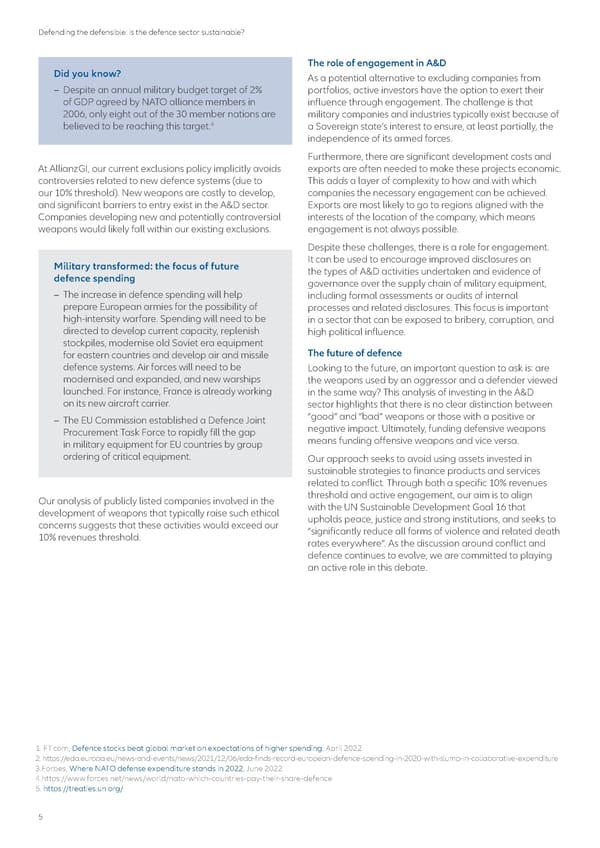Defending the defensible: is the defence sector sustainable? The role of engagement in A&D Did you know? As a potential alternative to excluding companies from – Despite an annual military budget target of 2% portfolios, active investors have the option to exert their of GDP agreed by NATO alliance members in influence through engagement. The challenge is that 2006, only eight out of the 30 member nations are military companies and industries typically exist because of believed to be reaching this target.4 a Sovereign state’s interest to ensure, at least partially, the independence of its armed forces. Furthermore, there are significant development costs and At AllianzGI, our current exclusions policy implicitly avoids exports are often needed to make these projects economic. controversies related to new defence systems (due to This adds a layer of complexity to how and with which our 10% threshold). New weapons are costly to develop, companies the necessary engagement can be achieved. and significant barriers to entry exist in the A&D sector. Exports are most likely to go to regions aligned with the Companies developing new and potentially controversial interests of the location of the company, which means weapons would likely fall within our existing exclusions. engagement is not always possible. Despite these challenges, there is a role for engagement. Military transformed: the focus of future It can be used to encourage improved disclosures on defence spending the types of A&D activities undertaken and evidence of governance over the supply chain of military equipment, – The increase in defence spending will help including formal assessments or audits of internal prepare European armies for the possibility of processes and related disclosures. This focus is important high-intensity warfare. Spending will need to be in a sector that can be exposed to bribery, corruption, and directed to develop current capacity, replenish high political influence. stockpiles, modernise old Soviet era equipment for eastern countries and develop air and missile The future of defence defence systems. Air forces will need to be Looking to the future, an important question to ask is: are modernised and expanded, and new warships the weapons used by an aggressor and a defender viewed launched. For instance, France is already working in the same way? This analysis of investing in the A&D on its new aircraft carrier. sector highlights that there is no clear distinction between – The EU Commission established a Defence Joint “good” and “bad” weapons or those with a positive or Procurement Task Force to rapidly fill the gap negative impact. Ultimately, funding defensive weapons in military equipment for EU countries by group means funding offensive weapons and vice versa. ordering of critical equipment. Our approach seeks to avoid using assets invested in sustainable strategies to finance products and services related to conflict. Through both a specific 10% revenues Our analysis of publicly listed companies involved in the threshold and active engagement, our aim is to align development of weapons that typically raise such ethical with the UN Sustainable Development Goal 16 that concerns suggests that these activities would exceed our upholds peace, justice and strong institutions, and seeks to 10% revenues threshold. “significantly reduce all forms of violence and related death rates everywhere”. As the discussion around conflict and defence continues to evolve, we are committed to playing an active role in this debate. 1. FT.com, Defence stocks beat global market on expectations of higher spending, April 2022 2. https://eda.europa.eu/news-and-events/news/2021/12/06/eda-finds-record-european-defence-spending-in-2020-with-slump-in-collaborative-expenditure 3.Forbes, Where NATO defense expenditure stands in 2022, June 2022 4.https://www.forces.net/news/world/nato-which-countries-pay-their-share-defence 5. https://treaties.un.org/ 5
 Defending the defensible: is the defence sector sustainable? Page 4 Page 6
Defending the defensible: is the defence sector sustainable? Page 4 Page 6